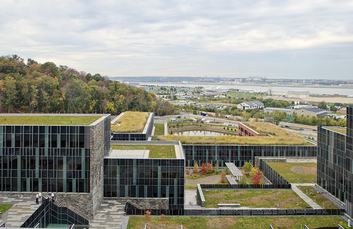
31 acres of greenery. Imagine if our buildings used vegetation to accomplish key performance goals: increasing cost-saving insulation, extending roof life by decades, soaking up rain to avoid water-polluting runoff and related fees, providing wildlife habitat, and reducing the urban heat island effect.
The U.S. Coast Guard Headquarters, pictured here, does all that, with the 2nd largest living roof in the U.S. In fact, GSA’s commitment to high performance buildings has resulted in over 60 of our buildings sporting more than 2 million square feet of living roofs.
What are living roofs? Roofs that are fully or partially covered with vegetation on top of a growing medium and waterproofing membrane. GSA’s report, "The Benefits and Challenges of Green Roofs on Public and Commercial Buildings" documents the benefits, costs, best practices, and research needs of living roofs. The report estimated a 6.2-year payback for this technology on commercial and public buildings.
For a more comprehensive primer on living roofs, from engineering needs to plant selection and case studies, see Planted Roofs on SFTool.
“More than just an add-on, our living roof is an integrated design strategy that greatly impacts our building’s operations, its community, and the environment in numerous ways.”
- Montserrat Agleham, 50 United Nations Plaza Project Manager
Ken Sandler is OFHPB’s contact on living roofs. Lance Davis coordinates living roof projects for GSA’s Public Buildings Service (PBS). |